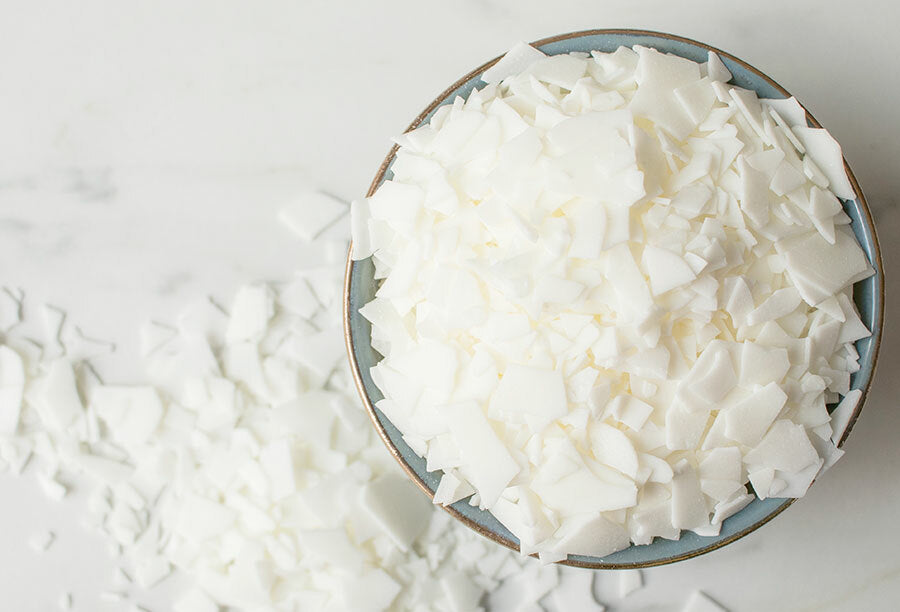I often get asked about candle wax - what type of wax do we use? what are the benefits? how does soy differ from paraffin? and the list goes on. this blog will hopefully provide you with some useful information on soy wax, paraffin wax, the benefits, the dangers, and why we use what we use.
what is soy wax & how is it made?
soy wax is derived from the vegetable, soybeans. these soybeans are harvested and then cleaned, cracked, de-hulled, and rolled into flakes or pellets. the oil is then extracted and hydrogenated. this saturates some of the fatty acids in the oil and allows the wax to become solid when at room temperature. what is left of the bean husks are then used as animal feed, so very little goes to waste.
the US is known to be one of the main growers of soybeans in the world, and the most popular states for doing so are Illinois, Iowa, and Indiana.
soy wax is natural, kosher, and renewable - which means it is friendly to both you & the environment. not to mention, the process to make soy wax is environmentally friendly and utilizes renewable resources.
what is paraffin wax?
paraffin wax was first discovered in 1830 by Carl Reichenbach in Germany. this was a huge advancement for candle making - which traditionally had been done using tallow (oil from beef fat) - as it was easier to work with and much less expensive. paraffin wax is derived from petroleum, coal, or oil shale. this is typically the wax utilized by "big box" stores (and even some smaller candle makers) because it is less expensive than natural wax alternatives, easy to work with, takes on dyes well, and holds a lot of scent. if your candle does not specify soy wax, coconut apricot wax, beeswax, etc. it's most likely made from paraffin.
what are the dangers of paraffin wax?
both soy & paraffin wax are derived from oil. however, the first red flag that you should see is that paraffin wax is derived from petroleum (aka what you put into your car) while soy wax is derived from natural soybean oil. burning a paraffin candle is essentially like turning on your car and letting the fumes from the exhaust fill your home. when burned, paraffin emits toluene and benzene into the air, which are incredibly toxic and carcinogenic chemicals. it also produces higher levels of soot than natural waxes, which not only turn your candle jar black, but can stain your walls and ceiling.
are you ever burning a candle and all of sudden get a headache? paraffin wax is also known to cause headaches and nausea - and sometimes even insomnia. so that new lavender or eucalyptus candle you just purchased hoping it would lull you into sleep, is actually keeping you up!
one of the scariest features of paraffin wax, because of the emission of toluene, is the potential for birth defects. if you're pregnant, always consult a doctor before burning a candle, but it's safe to say you should never burn a paraffin candle while carrying a baby. this gas has been studied around both pregnant humans and animals and caused significant birth defects in both! toluene is also one of the chemicals emitted when smoking cigarettes. so if you wouldn't smoke while pregnant, then you shouldn't burn a paraffin candle either.
not to mention, paraffin wax is a byproduct of a nonrenewable resource which means it is unfriendly to the environment. so while it's not doing any good for you, it's harmful to the earth also.
what type of wax do we use?
within the world of wax, there are many, many, many options including plenty of blends (coconut-soy blend, paraffin-soy blend, beeswax, and more). the soy wax we use is 100% natural soy with some soy-based additives included to increase the effectiveness of the wax, the scent, and the shelf life of the candle. these preservatives are common in a lot of the food we consume and the FDA recognizes them as generally being safe.
what are the benefits of soy wax & why do we use it?
most importantly, soy doesn't contain the harmful chemicals, carcinogens, and toxins that paraffin does. it does not contain parabens, phthalates, paraffins, and we also don't use any dyes (which typically paraffin wax candles do). it also can have a longer burn time than other types of wax and ultimately, burns cleaner.
one of soy's greatest benefits is also that it is completely renewable. oil is becoming less and less available, which is causing prices to rise, including the price of paraffin wax. soy will continue to be available as long as it continues to be farmed. it is not limited by the natural resources of the earth, like a paraffin wax is. and as soon as it's harvested, more can be planted in its place. as soy wax gains popularity and people are making the conscious switch, it will then employ more farmers and encourage more domestic jobs!
soy is eco-friendly, renewable, grown in the US (matching our brand commitment to only purchase products from the US), sustainable, and more.
now, obviously I love soy wax and want to continue to share the benefits of it over dangerous alternatives. but if you're buying a scented candle (which most of us are), then you also need to consider the other components of the candle including the fragrance and the wick. while the wax is roughly 90% or more of the candle, the other components shouldn't be ignored. it's all well and good to buy soy wax and enjoy the benefits of paraben-free and phthalate-free materials, but if the fragrance that is being used contains them or the wicks have lead in them, then you're only halfway there. stay tuned for a future blog explaining the types of fragrance oils that are typically used in candles, some of the misleading language around "essential oil candles", and what types of fragrance oil we use. a little hint - we only use incredibly high quality ones! and spoiler, we only use lead-free wicks.
in the end, the decision of what type of wax or candle you want in your home is totally up to you. I'm not a doctor and I can't make health decisions for you, but I can share the education that I have learned along the way as a professional candle maker. and hopefully that will encourage you to learn something new, do some research on your own if desired, and ultimately make the switch to en mer!

